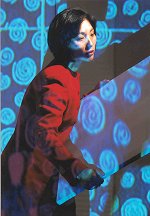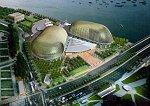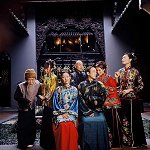|
ARTS RENAISSANCE ON THE ASIAN EQUATOR
by Kalina Stefanova
Imagine being in the biggest cathedral you've ever seen, only the ceiling has been lifted up, as if to the very sky, and instead of walls, somewhere in the distance---way above your head, there's something like a forest of slightly slanted light-timber beams. Imagine also that all this splendor is imbued with shining, yet soft, caressing light, coming from the sun-like figure which hangs up there where the 'forest' ends... Well, you don't need to imagine. You may simply experience that fusion of the classical and science-fiction, if you go to the Concert Hall of The Esplanade-Singapore's new arts complex, which opened doors last October with a grand three-week festival. I had a chance to visit, back in June 2002, when they were putting the final touches to the building, and even then the Concert Hall already had the breathtaking effect of an unearthly temple.

Occupation
Theatres on the Bay is the other name of The Esplanade because it stands on the waterfront in the civic district and harbors also a 2000-seat horse-shoe shaped, Italian opera-house style Theatre, two flexible-space Studios for up to 220 and 250 people respectively, the first Performing Arts Library in Singapore, several exhibition premises, and two outdoor theatres. Yet, the jewel in its crown is the 1600-seat Concert Hall which, with its 4889-pipes Klais organ, superb reverberation chambers, acoustic canopy and curtains, boasts optimum sound quality. It also has a built-in possibility for 200 more seats in the gallery, behind the orchestra, thus adding to its other assets an arena-stage effect. Lucky those who were there during the opening festival, when center stage was taken by the London and New York Philharmonics, Jessye Norman and Lincoln Center Jazz Orchestra, and the like!

The Esplanade
But the classical and the modern won't always dwell separately on The Esplanade's stages. Actually they definitely mixed from the very beginning: in the world premiere of Marco Polo and Princess Blue, the tenor (Polo) sang Broadway-style while the soprano (Princess Blue) stuck to the opera canon. This combination encapsulated the very spirit of The Esplanade---modern, yet true to traditions, universal, yet unmistakably Asian. And this mixture was on display throughout the entire opening festival: with Faust (the silent film classic) accompanied with pipe organ, the National Ballet of China version of Raise the Red Lantern, WDR Big Band Cologne, Chinese pop and Indian, Malaysian and African traditional music...
All that multi-sensory feast, featuring some 1200 artists from 22 countries, started with another blend-of outdoor and indoor arts, truly reflecting The Esplanade's vision to be 'for everyone'. An open-air fiesta was followed by the world dance premiere of Reminiscing the Moon and Harbor Spectacular---30 minutes of French fireworks and Quebec street theatre and puppetry.
The down-to-earth and the high-brow coexist in the very structure of The Esplanade: intertwined between the theatres and encompassing a satellite box-office and the library, there is a shopping mall. A unique way of counteracting the effects of the mall culture: not by sniffing at it and downright rejecting it but by inviting people to indulge both their material and spiritual needs. As The Esplanade proudly announces at its entrance, its mission is 'to entertain, engage, educate and inspire.'
What about the outside look of the new utopian-like venture of Singapore? You have to summon up your imagination again. And what a choice you have! Here's what The Esplanade's twin glass shells, coated with spiky sunshades, have been compared to: golf balls, pineapples, fly's eyes, durians (the tropical fruit), hedgehogs, sliced microphones...
My choice is the mikes. Because from now on via The Esplanade Singapore will be talking to the rest of the world. And one of its messages will be that it aspires to become a Global City for the Arts. In other words: yes, we all know that it has mastered the money-talk but we are to find out that it's getting fluent in the other lingua franca-the language of the arts.
Does Singapore have, though, all the makings to fulfill that ambition? It sure has the infrastructure, education, and management (The Esplanade costs $600 million and it's all from horse-racing taxes and lottery!). But is there a local artistic pool to draw from or Singapore will rely on international extravaganzas and foreign talent mainly to make its Esplanade work full steam?

"Morning people"
By the courtesy of the Singapore Arts Festival"
The three-and-a-half-week annual Singapore Arts Festival, taking place in June and headed by the talented and remarkably inventive Ms. Goh Ching Lee, provides the answer and it's an undoubted YES, Singapore does have a considerable artistic potential of its own! Two lengthier ways of saying so last year were the Festival's commissions of the theatre productions Occupation and The Morning People.
The text of The Morning People is an exquisite example of how the classics can be radically adapted and yet sound as if written by the original author, when the bottom-line approach of the adapter is not deconstruction but reverence (coupled, of course, with first-rate talent). The credit here goes to the already world-famous, LA-based Singaporean Chay Yew who has managed to step into the shoes of Chekhov while taking his Cherry Orchard as a basis, intertwining in it texts, plots, characters or just nuances from Three Sisters, Uncle Vanya, and The Seagull, and finally coming up with a very Chekhovian story which takes place circa 1934 in Qing Dynasty Manchuria, just before communism steps onto the stage.
The production of Goh Boon Teck (an outstanding young Singaporean director, here also a set-designer) strives to be on the level of the script and goes for a very high start. The opening scene introduces the leading character before her arrival back home: on a transparent screen, rolled down in front of the stage, Madam Siet (the Chinese double of Ranevskaya), clad in a very Western, 1930's dress, lights a cigarette, revels in inhaling and then starts singing also a very Western song (she's left Manchuria to become a lounge singer in London, we'll learn later). At the same time, through her black-and-white image, we see silhouettes of Chinese people running around with red lanterns in the twilight-obviously the feverish preparations for her welcome home are in full swing. These few first minutes are so intensely charged with the 'those-days' atmosphere and are so meltingly powerful that, when the screen rolls up, one finds oneself swept off and transported as if right up there-among the dwellers of Madam Siet's much beloved cherry estate.
Projections serve as a time-machine in Occupation too. Only here they go on throughout the show: as an indelible part of the ascetic set, as characters intertwined in the narrative (in the shape of silhouettes), and as a potent symbol of the mosaic of human memory. An interviewer tries to bring up and piece together the story of a woman falling in love and marrying 60 years ago, during the Japanese occupation of Singapore and Malaysia-the real story of the grandmother of the author, Hazul Sulaiman, a young Malaysian star playwright. The stage is brimming with characters but unlike The Morning People's large-scale cast, here it's just one actress who enacts them all---Claire Wong (also co-directing in tandem with Sulaiman).
With very few misses, the two shows are superbly performed, directed, written and designed. But it's not only the talent index which makes them world-class. They also fit perfectly well into one of the world theatre's main tendencies today-that of the post-political. In both shows the action takes place during rough times, when politics and its consequences wreak havoc and transform human lives into plots for tragedies. Yet all that--otherwise called History---is not what takes center stage. The spotlight is reserved for the human beings who go on living and even find strength to enjoy life in spite of everything. Because, as Sulaiman puts it, 'history is not what happens to nations and races, it's what happens to mothers and fathers, daughters and sons.' And these people are not treated as victims but as the vital core of life that actually makes the world go round.
Is this theatre in fact totally apolitical? Not at all. Because it also has a clear protest-vote statement: we are fed up with politics and all it's done to people, it says. In the end political and economic systems come and go, and it's humanity that stays and defines us as people. A brilliant plot move introduced by Chay Yew in The Morning People pinpoints that message: the Chinese equivalent of the newly-fledged bourgeois Lopahin gets Madam Siet's hereditary cherry orchard but the communist march is round the corner, so the acquisition won't be his for long...
Yes, Singapore definitely has its own potential to invite people to the tent of the theatre and tell them stories. And its new magical tents--The Esplanade's 'sliced mikes' which during the night look like lit lanterns-- will be a good reminder that these stories may be universal but the story-teller is truly Asian and uniquely Singaporean.
|